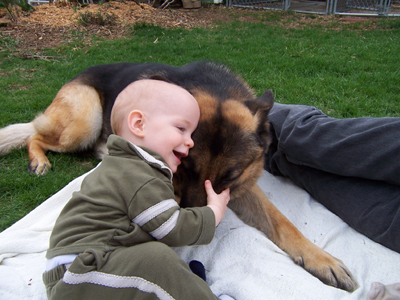Rover, Meet Junior
If your first child has a wet nose or a sandpaper tongue, he might need a little help adjusting to baby #2
Does it feel like your dog is even more clueless about your pregnancy than your husband? Think again!
Your pet probably was the very first to notice something different about you. Animals are in tune to their owners and can sense when things have changed. “They’ll notice the change in hormone levels in an owner that they are really attached to,” says Penny Scott-Fox, author of And Baby Makes Four: A Trimesterby- Trimester Guide to a Baby-Friendly Dog.
Joanne Sanders of Atlanta, remembers, “When I became pregnant, our dog looked at me differently, as if she knew. As I got bigger, she grew very protective and was even more cuddly than usual.” Scott-Fox says that it’s common for pets to become more affectionate while their pregnant owner grows.
And that positive attitude should continue on into baby’s arrival, in most cases: Scott-Fox estimates that about 98% of dogs will get along with a bab y. “But there are a few dogs that will not get along. If you’re in any doubt, seek the expertise of a dog trainer,” she recommends.
Still, you can do the work of getting your pet adjusted to baby yourself, without a trainer’s help, if you don’t run into problems.A key point is the introduction: Give your pet a chance to be well mannered when the baby comes home.
DOG, MEET BABY
“When you first walk in the door with a newborn, that’s not the best time for your pet to meet the baby,” says Jennie Willis Jamtgaard, Ph.D., an applied animal behaviorist at Colorado State University’s College of Veterinary Medicine & Biomedical Sciences in Fort Collins.
There’s a lot of excitement, and your pet could be worked up about your return. So It’s best that he meet the baby when he’s had a chance to calm down. Have one caregiver take your pet (or pets) in another room and give lots of attention until he relaxes a bit; then bring him back into the room, Jamtgaard says.
It’s a good idea to hand out treats to both dogs and cats during the adjustment period.“Let [pets] associate happy things with the bab y by adding food to the introduction,” Jamtgaard says. It worked for Matthew Matsuoka in Richmond, CA, who was concerned about their cat, Wasabi, when he and his wife brought their newborn son home.
“Wasabi’s always disliked strangers,” Matsuoka says. “So I made sure he got the same or more attention when Jackson came home . I gave him more snacks and made sure I kept to his morning and evening rituals of feeding and grooming. I also let Wasabi continue to sleep in bed with us but kept the cat and baby apart.”
SHARE THE LOVE
Matsuoka was right to give attention to baby and pet simultaneously. Like people, pets need to feel loved and secure.
Michaella Scanlon and her husband, in Olney, MD, used this technique for introducing their pets to both of their kids when they were infants: One parent would have a pet by his or her side—whether it was a dog, cat, or bunny—and the other would have the baby. “We each gave a lot of attention to the individual in our care, then we traded. The pets understood that they weren’t going to be neglected and that they didn’t outrank the baby, at the same time ,” Scanlon says.
The key is remembering your pets. Continue to snuggle with your dog and stroke your cat.“Don’t put them on the back burner because the family has changed,” Scott-Fox says. “They serve a great purpose, so don’t forget them during this exciting time in your life.”
Sharon Anne Waldrop and her husband are the parents to 14 human, canine, and feline children.Her freelance writing keeps everyone well fed and vaccinated. She’s also written for Good Housekeeping, American Baby, and Woman’s Day.
PREPARING PETS FOR CHANGE
When you’re pregnant, your dog or cat probably knows that something is about to happen, but can’t understand exactly what the differences mean.“We need to help pets know what’s coming,” Scott-Fox says. And when baby gets home there will be unavoidable changes, but you can make the adjustment a positive experience for everyone with a few important steps:
• Set up the nursery and place baby items around your house before your delivery, so they’re familiar things, not new ones, when baby arrives.
• If anything in your pet’s routine will be different after baby’s birth, such as where the dog or cat will eat or sleep, make the change well before the birth.
• Send your husband or partner home from the hospital with a cap or receiving blanket that smells like baby, and have him hold it while your pet sniffs.
• If your pet has any annoying behaviors, such as excessive barking, resolve the issue before the baby arrives. Help is available online, in books, or from a trainer.
• A dog that is trained to obey basic voice commands is an easier dog to control when you’re busy with your baby. Sit, stay, come, and quiet are good words for her to know, and it’s not too late to teach her.
• Dogs who get nervous around new people should be conditioned to ease their anxiety toward strangers. Try rewarding your dog when he meets new people and it goes well, even having the strangers hand him the treats.
By Sharon Anne Waldrop
